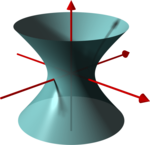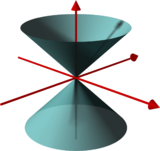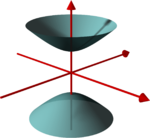
Back Hiperboloïed Afrikaans سطح زائدي Arabic Hiperboloid BS Hiperboloide Catalan ڕووی بڕگەزیادی CKB Hyperboloid Czech Гиперболоид CV Hyperboloid German Hiperboloido Esperanto Hiperboloide Spanish
 Hyperboloid of one sheet |
 conical surface in between |
 Hyperboloid of two sheets |
In geometry, a hyperboloid of revolution, sometimes called a circular hyperboloid, is the surface generated by rotating a hyperbola around one of its principal axes. A hyperboloid is the surface obtained from a hyperboloid of revolution by deforming it by means of directional scalings, or more generally, of an affine transformation.
A hyperboloid is a quadric surface, that is, a surface defined as the zero set of a polynomial of degree two in three variables. Among quadric surfaces, a hyperboloid is characterized by not being a cone or a cylinder, having a center of symmetry, and intersecting many planes into hyperbolas. A hyperboloid has three pairwise perpendicular axes of symmetry, and three pairwise perpendicular planes of symmetry.
Given a hyperboloid, one can choose a Cartesian coordinate system such that the hyperboloid is defined by one of the following equations: or The coordinate axes are axes of symmetry of the hyperboloid and the origin is the center of symmetry of the hyperboloid. In any case, the hyperboloid is asymptotic to the cone of the equations:
One has a hyperboloid of revolution if and only if Otherwise, the axes are uniquely defined (up to the exchange of the x-axis and the y-axis).
There are two kinds of hyperboloids. In the first case (+1 in the right-hand side of the equation): a one-sheet hyperboloid, also called a hyperbolic hyperboloid. It is a connected surface, which has a negative Gaussian curvature at every point. This implies near every point the intersection of the hyperboloid and its tangent plane at the point consists of two branches of curve that have distinct tangents at the point. In the case of the one-sheet hyperboloid, these branches of curves are lines and thus the one-sheet hyperboloid is a doubly ruled surface.
In the second case (−1 in the right-hand side of the equation): a two-sheet hyperboloid, also called an elliptic hyperboloid. The surface has two connected components and a positive Gaussian curvature at every point. The surface is convex in the sense that the tangent plane at every point intersects the surface only in this point.
© MMXXIII Rich X Search. We shall prevail. All rights reserved. Rich X Search



